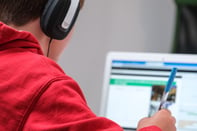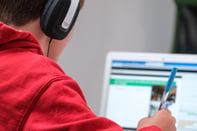Published on
Keeping the Classroom Community Online

What an interesting and scary time to be in higher education!
All of my post-master’s work has been done through remote learning experiences. The majority of the courses have been virtual learning opportunities. This was a key factor in selecting both programs. My fear came from the online learning I experienced in the early 2000s, which was really just logging on and doing something, completing a task, but didn’t really engage most students.
My professors at the University of North Dakota and Appalachian State University truly set a high standard in online learning. I truly felt connected to the professors, the universities, and my peers in the classroom. This was very different from earlier online learning experiences. When I began the EdS Cohort at AppState, I was told by the director that it was the first online cohort. I was a bit nervous because I wanted the community and connection of a seated class; however, a seated class was not an option for me (a 4-hour drive from Boone, on top of a 40+ hour workweek and general, adulting).
The things that transpired in this course, and every other course in the program, were beautiful. A community was built. Mutual respect was modeled. Students drove the learning. We became friends–. many of us have even stayed connected since completing the program. The professors were 100% supportive and available. I felt more connected to my peers in this program than I did in my seated classes. I felt valued by my professors. For that, I am grateful (shout out to Dr. B, Dr. K, and Dr. L-B for ‘getting’ how to build communities).
I work at a small community college in a rural area. Large cities are more than one hour away by car. Most of my students are either low-income, first-generation students, or both, and many are minority students. The area is home to roughly 27,000 people -– as many as 30% do not have Internet access (US Census Bureau QuickFacts, 2020). Local statistics show that nearly 21% of the population is below the poverty line. The average household income is just over $38,000, but the per capita income is less than $20,000 (Montgomery County, NC, 2020). To say that the area is economically disadvantaged is an understatement. The local community college is the sole provider of higher education in the county. The student population includes many students who are dual enrolled. My college, like most colleges, has recently been forced to shift instruction to an entirely online format. As a student of higher education, instructional design, online learning, and curriculum, I know that this means more than just ‘dumping content into an LMS.’
Even though this rapid shift to online instruction has required teachers to move from a seated classroom to an online classroom (literally) overnight, we must be intentional about how we design learning. Jennifer Gonzalez, of The Cult of Pedagogy, challenges us to be curators, rather than dumpers, insisting that we plan instruction in a meaningful way that is meaningful. This is especially important when we are designing instruction in an online format. Gonzalez (2018) writes:
We have machines to provide information, to dump it all in a pile in front of us. What really smart, intuitive humans can do for each other—as teachers, as colleagues, as administrators—is curate. If we aspire to call ourselves master teachers, we also should be clear on what that actually means. The essence of our work is taking vast swaths of information and helping our students make sense of it (para. 36).
I know that initially we had to make a very fast shift very fast. The immediate the goal was to get something up so that students could start their work. Students often ask why they need to remember things when they can look it up on their phones. Yes, cell phones have the ability to load a lot of information onto a screen, but they cannot design meaningful learning experiences. My hope is that as we are more than one week into what will most certainly be many weeks of virtual instruction, we have started to think about two primary objectives. The first one, at least for me, is to maintain the classroom community; the second one is to develop materials, media, and assignments that I would have (or could have) selected for the seated class.
My virtual learning experiences were made richer by the community that was created by my professors. I have an advantage that they did not -– I have been with these students for the previous eight weeks. I know their names, faces, and quirks. I also know who normally sits with whom and who texts the other about assignments and announcements. The challenge is now getting students to attend the live sessions because there are obstacles (the desire to sleep in, the lack of Internet, work/family responsibilities, and the list goes on) and keeping them engaged with one another while they’re apart from one another.
My virtual learning experiences were also enriched by meaningful assignments — not assignments that “filled space,” “take a certain amount of time to complete,” or met some other check list item. Yes, it would be much easier for me to dump some assignments into the LMS. My responsibility is now to create meaningful learning experiences that would fill the time when students work in small groups to discuss big topics and events.
The first day of virtual teaching was March 17th, 2020. I was brave. I sent out a link for Google Meet and asked the students to log in at the normal time for class. Seven students (of 22) logged in. Many of my students either don’t have Internet, or rely on mobile hotspots, at home (fortunately access is improving in the wake of this crisis). They are young and it is tempting to sleep in. But. They. Came.
I was excited by their participation and I (hastily) wrote: “Rome is not burning.” I regret those words now because, for many, Rome is burning. What I should have said is: “In spite of the global turmoil, people are craving the norm, routine, and safety of their classroom. In spite of the challenges, learning continues.” As I am preparing to begin week three, remote learning is going better than I could have anticipated, all things considered.
In the past week, participation has continued to increase. More students are logging in. They are beginning to ask questions. They actually seem to like virtual learning (or maybe the part where they can attend class from the comfort of their beds while still in their pajamas). Some log in and others dial in. The important thing is that they are attending. They are adapting. And they are doing great work! I am so proud of them. I am grateful that they have been willing to adapt and be patient.
In order to reach the students who are unable to attend the live sessions, I have been recording my lectures. All students still have access to the same in-class activities, just as they would have before COVID-19. I have compiled all of this information and/material onto a Google site, which is easier to access from a smart phone than the LMS.
This shift happened so quickly that I was unable to read articles and blogs from other educators. Ordinarily, I devote regular time for reading education articles, but there hasn’t been enough of it. I have a list of links saved in Word. Maybe I will get to those this summer.
Is everything great? Absolutely not! Am I scared for the students who I know experience food insecurity? Yes, they are on my mind. Am I concerned for the students who are working instead of attending class? Definitely! COVID-19 has taught me a lot about myself. It has taught me that I am much more flexible and adaptable than most people think (including myself). I like to plan. I like to prepare. I like to feel in control. I like structure. I like rules. During this time, plans have changed and preparation has shifted. I no longer have the illusion of control because everything is changing rapidly. Structure? I am working long and odd hours (though oddly not feeling tired). Rules? Well, the rule is: “Do the best you can, with what you have, where you are.”
COVID-19 has changed higher education in ways that we are not even aware of right now. COVID-19 had forced many out of their comfort zones and out of their routines. COVID-19, I hope, is challenging us all to be more intentional in how we design remote instruction. I have modeled a lot of my own professor’s’ teaching styles. I feel like I was prepared for remote teaching because of my learning experiences; however, I was not prepared for the challenges that many students are now facing.
I am grateful for the students who are persevering. They are inspiring. In the midst of the anxiousness that has taken over society, humans are resilient.
Editor’s note: This article was submitted on March 30, 2020.
—-
References
Gonzalez, Jennifer. “Are You a Curator or a Dumper?” Cult of Pedagogy, September 20, 2018. https://www.cultofpedagogy.com/curator-or-dumper/.
“Montgomery County, NC.” Data USA. Accessed March 24, 2020. https://datausa.io/profile/geo/montgomery-county-nc.
“U.S. Census Bureau QuickFacts: Montgomery County, North Carolina.” Census Bureau QuickFacts. Accessed March 24, 2020. https://www.census.gov/quickfacts/montgomerycountynorthcarolina.
Author Perspective: Administrator



